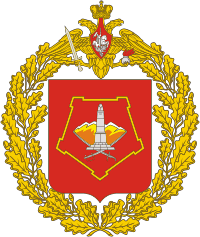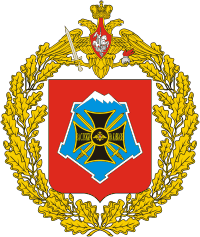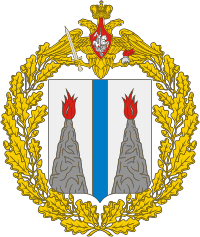
The Soviet Air Defence Forces was the air defence branch of the Soviet Armed Forces.
In warfare, a theater or theatre is an area in which important military events occur or are in progress. A theater can include the entirety of the airspace, land and sea area that is or that may potentially become involved in war operations.

The 1st Guards Army was a Soviet Guards field army that fought on the Eastern Front during World War II.

The Leningrad Military District is a military district of the Armed Forces of the Russian Federation. In 2010 it was merged with the Moscow Military District, the Northern Fleet and the Baltic Fleet to form the new Western Military District. In December 2022, Defense Minister Sergey Shoigu proposed to reestablish it along with the Moscow Military District, a decision confirmed in June 2023 by Deputy Chief of the General Staff Yevgeny Burdinsky. On December 17, 2023 Vladimir Putin announced plans to recreate the Leningrad Military District as a reaction to Finland joining NATO. The district was formally reconstituted on February 26, 2024 by a Presidential Decree.

The Baltic Military District was a military district of the Soviet armed forces in the Baltic states, formed shortly before the German invasion during World War II. After the end of the war the Kaliningrad Oblast was added to the District's control in 1946, and the territory of Estonia was transferred back to the Baltic Military District from the Leningrad Military District in 1956. The Baltic Military District was disbanded after the fall of the Soviet Union in 1991 and reorganised into the North Western Group of Forces, which ceased to exist following the withdrawal of all Russian troops from Estonia, Latvia and Lithuania on 1 September 1994.

The Volga–Ural Military District was a military district of the Russian Ground Forces, formed on 1 September 2001 by the amalgamation of the Volga Military District and the Ural Military District. The headquarters of the Ural Military District, located at Yekaterinburg became the new headquarters of the merged district. In 2010 the District was merged with part of the Siberian Military District to form the new Central Military District.

The North Caucasus Military District was a military district of the Russian Armed Forces from 1992-2010. Before 1992 it had been part of the Soviet Armed Forces since 1918. In 2010 it became the Southern Military District and lately also included the Black Sea Fleet and Caspian Flotilla.

The Far Eastern Military District was a military district of the Armed Forces of the Russian Federation. In 2010 it was merged with the Pacific Fleet and part of the Siberian Military District to form the new Eastern Military District.

The Transcaucasian Military District, a military district of the Soviet Armed Forces, traces its history to May 1921 and the incorporation of Armenia, Azerbaijan, and Georgia into the Soviet Union. It was disbanded by being redesignated as a Group of Forces in the early 1990s after the Soviet Union collapse. The military district formed as a basis of the modern day armed forces of Armenia, Azerbaijan, and Georgia as well as unrecognized polities of Abkhazia, the Republic of Artsakh and South Ossetia.
A rifle corps was a Soviet corps-level military formation during the mid-twentieth century. Rifle corps were made up of a varying number of rifle divisions, although the allocation of three rifle divisions to a rifle corps was common during the latter part of World War II.

The Transbaikal Military District was a military district of first the Soviet Armed Forces and then the Armed Forces of the Russian Federation, formed on 17 May 1935 and included the Buryat Republic, Chita Oblast, and Yakutia. Chita was the headquarters of the district. It was finally disbanded on 1 December 1998 by being amalgamated with the Siberian Military District, though Chita remained the headquarters of the new amalgamated district.

The Soviet Airborne Forces or VDV was a separate troops branch of the Soviet Armed Forces. First formed before the Second World War, the force undertook two significant airborne operations and a number of smaller jumps during the war and for many years after 1945 was the largest airborne force in the world. The force was split after the dissolution of the Soviet Union, with the core becoming the Russian Airborne Forces, losing divisions to Belarus and Ukraine.

The 51st Army was a field army of the Red Army that saw action against the Germans in World War II on both the southern and northern sectors of the front. The army participated in the Battle of the Kerch Peninsula between December 1941 and January 1942; it was destroyed in May 1942 with other Soviet forces when the Wehrmacht launched an operation to dislodge them from the peninsula. The army fought in the Battle of Stalingrad during the winter of 1942–43, helping to defeat German relief attempts. From late 1944 to the end of the war, the army fought in the final cutting-off of German forces in the Courland area next to the Baltic. Inactivated in 1945, the army was activated again in 1977 to secure Sakhalin and the Kuril Islands. Following the dissolution of the Soviet Union, the army continued in existence as a component of the Russian Ground Forces. The army was active during two periods from 1941 until 1997.
The 19th Army was a field army of the Soviet Union's Red Army, formed in 1941 and active during the Second World War. The army was formed three times, although only two of its formations saw combat.
The 39th Army was a Field Army of the Soviet Union's Red Army during World War II and of the Soviet Army during the Cold War.

The 28th Army was a field army of the Red Army and the Soviet Ground Forces, formed three times in 1941–42 and active during the postwar period for many years in the Belorussian Military District.
The 13th Guards Airborne Division was a division of the Soviet Airborne Troops.
The 166th Rifle Division was an infantry division of the Soviet Union's Red Army that fought in World War II, formed twice. The division's first formation was formed in 1939 and wiped out in the Vyazma Pocket in October 1941. In January 1942, the division reformed. It fought in the Battle of Demyansk, the Battle of Kursk, Belgorod-Khar'kov Offensive Operation, Vitebsk–Orsha Offensive, Polotsk Offensive, Šiauliai Offensive, Riga Offensive and the Battle of Memel. It was awarded the Order of the Red Banner.

The Primorsky Military District was a military district of the Soviet Armed Forces that existed in from 1945 to 1953. Formed from the headquarters of the 1st Far East Front after the end of World War II, the district controlled troops on the territory of Primorsky Krai, North Korea and the Kwantung Peninsula. It was disbanded in 1953 and the territory became part of the Far Eastern Military District.













